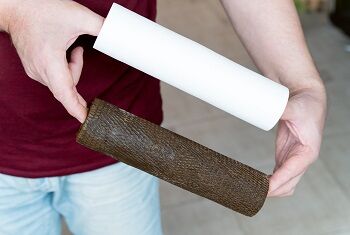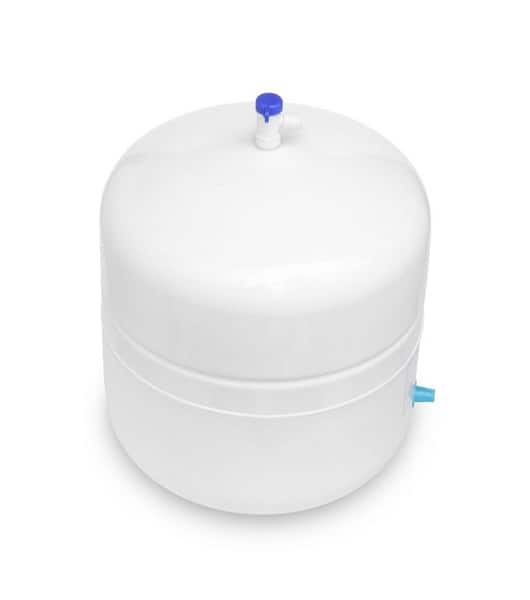UPDATED March 8, 2022
You come in from the hot day outside, and nothing would be better than a nice tall drink of water from your reverse osmosis. You put your glass under the faucet and watch sadly as your glass takes so long to fill. And your thinking…
Slow water flow from a reverse osmosis system is due to inadequate water pressure. Poor water pressure is caused by clogged filters, incorrect air pressure in your water storage tank, a defective storage tank, a clogged membrane, or restricted water flow in or out of the reverse osmosis system.
A reverse osmosis drinking water system is a relatively simple system that should provide a good steady stream of quality drinking water for you, if it is not, here are the likely reasons why.
I put them in order from the most common reason to the least common so you should have your reverse osmosis system flowing great very soon.
8 Most Common Reasons For Slow Water Flow From A Reverse Osmosis System.
- Clogged Pre Or Post Filters
- Storage Tank Pressure Too Low Or Too High
- Clogged Reverse Osmosis Membrane
- Increase In RO Water Usage
- Hole Or Tear In Your Storage Tank Bladder
- Kinked Tubing On RO System
- Restricted Water Flow In Or Out Of Your Reverse Osmosis System
- A Drop In Your Homes Incoming Water Pressure
Slow Reverse Osmosis Water Flow Checklist!
| Possible cause! | What to do! |
| Clogged Pre Or Post Filters | Change your reverse osmosis filters and sanitize your reverse osmosis system. |
| Storage Tank Pressure Too Low Or Too High | Check your reverse osmosis storage tank pressure by emptying it completely and making sure that the air pressure in the tank is between 7 and 8 PSI. |
| Clogged Membrane | Change your reverse osmosis filters and membrane. Check that the water being used by your reverse osmosis system is soft and free of iron. |
| Increase In RO Water Usage | More people using your reverse osmosis water may not give the system enough time to fill its storage tank which provides the strongest pressure. You could install a LARGER RO storage tank or an additional storage tank for additional stored water. |
| Hole Or Tear In Your Storage Tank Bladder | Completely empty your reverse osmosis storage tank and make sure the pressure in the tank is between 7 and 8 PSI. If you still have little to no water coming from the tank, replace the tank with a new reverse osmosis water storage tank. |
| Kinked Tubing On RO System | Make sure that all of the tubings of your reverse osmosis system are free of kinks or pinching. |
| Restricted Water Flow In Or Out Of Your Reverse Osmosis System | Check tubing of your reverse osmosis system for kinks or pinched tubing. Make sure the valve providing water to your reverse osmosis system is fully on and provides sufficient water flow. Check water flow from the reverse osmosis system to the faucet and through the faucet. |
| A Drop In Your Homes Incoming Water Pressure | Poor water pressure from a home well water pressure tank or a drop in municipal water pressure can cause your reverse osmosis tank not to fill and deliver slow water flow. |
You may have clogged Pre or Post Reverse Osmosis filters.

When was the last time that you changed your reverse osmosis filters?
If it has been a while, check out my article on “How often should I change my reverse osmosis filters?” to learn more about it.
A clogged pre-filter on a reverse osmosis system will cause the system to make filtered water slower than normal and therefore it will take longer to fill the system’s storage tank.
A typical in-home reverse osmosis drinking water system will take 2-4 hours to fill a standard-sized storage tank.
If just one of the reverse osmosis filters gets clogged, it may take much longer for you to have all the reverse osmosis water that you are used to having.
This will also reduce the water pressure going to the membrane which may reduce its ability to filter the water correctly because a reverse osmosis membrane works best when it compresses under pressure and makes the membrane openings smaller.
A clogged filter after the membrane can have a similar effect and can greatly reduce the quality of the water being produced by putting extra back pressure on the membrane.
Even if you have changed your reverse osmosis filters recently, there still could be clogging which can slow down your systems’ water flow.
Water from your well may have gotten stirred up from heavy rain which could clog your filters with sediment. The lack of rain may be causing sediment to get pulled up from your well because the water level has dropped.
Even if you have municipal water, any work that may have been done by your water provider could have caused debris to get into your water which can clog your filter.
Is the air pressure in your reverse osmosis storage tank too low, OR too high?

A standard air-charged reverse osmosis storage tank works best when the pressure in the tank when empty is between 7 and 8 pounds per square inch (PSI).
Making sure that the pressure in the storage tank is correct when it is empty will allow the bladder to fill to its ideal capacity while still having enough air pressure to let it empty completely.
Having too low pressure in your storage tank will allow the tank to fill but there will not be ample pressure to dispense all of the water from the bladder.
This will cause the water flow to slow down after only a small amount of water has been used and will often leave much of the water in the tank unused.
Some people think that adding more air to their storage tank will give them better water flow, and this is true, but it will also reduce the amount of water that the tank will hold.
If too much air is added to the empty storage tank, the bladder will not allow as much water into it as it should. This may provide a very strong water flow coming from the faucet, but the amount of water available will be less than ideal.
To check out the pressure in your reverse osmosis storage tank and make sure that it is performing as well as it should be, check out my article on “How to re-pressurize your reverse osmosis storage tank”.
your RO Membrane May Be Clogged From hard minerals or iron in your water.
If you have hard water or iron in your water, a water softener should be removing the iron and soften your water.
But if your water softener has stopped working or is not working correctly, hard minerals and iron could be getting into your reverse osmosis system and clogging your filters and membrane.
You can easily test to see if your water is soft and iron-free with an in-home water test kit like this one that I found.
Are you using more reverse osmosis water than usual?

With a standard air-charged storage tank, the speed of the water flow will diminish as the tank empties. If you are using more reverse osmosis water from your system than usual, the system may not be able to keep up as well as it used to.
More people using the system or even warmer temperatures outside when more water should be consumed may be causing the tank to only be partially filled most of the time, and therefore not flowing at maximum flow.
Check the flow first thing in the morning after the system has had plenty of time to fill completely.
If the flow is strong in the morning and then you notice that it is only slow during high usage times of the day, check out my article on “How to re-pressurize your reverse osmosis tank” to make sure your system is producing as well as it can.
There could be a tear in your reverse osmosis storage tank bladder.
If your RO is only delivering a glass of water before you see the pressure drop down considerably, this may be an indication that there is a hole or rupture in the storage tank bladder.
Although this is not common, over time an RO’s bladder can become weak from expanding and relaxing over and over again. This can cause small cracks in the rubber that eventually can become holes in the bladder.
To test if your bladder has ruptured, follow the steps outlined in my article on “How to re-pressurize a reverse osmosis storage tank”.
If the water flow still drops after only a glass or 2 of water, and the tank is several years old, it is most likely that the bladder in the tank is no longer functional and the tank needs to be replaced.
Fortunately, replacing an ROs storage tank is very easy, and they are not very expensive at all. I found this one on Amazon for a very good price, and it will work with nearly any reverse osmosis drinking water system.
4 Gallon RO Storage Tank
Check for a kink in the tubing of the system, and that all valves are open.
Although not very common, one of the reverse osmosis systems tubes may get bent or kinked which can slow or even stop the water flow.
If your system is underneath your kitchen sink like most are, people are taking things out and putting things in all the time, and sometimes those things can press against a piece of tubing causing a blockage.
Also, if the system’s drain line were to get out of alignment with the drain hole on your sink’s drainpipe, it would cause back pressure on the membrane of the system causing poor quality water and slowed water production.
There could be a drop in water pressure going to your reverse osmosis system.
Municipal water companies often do periodical maintenance on their water treatment equipment and pipes. During this time it is not uncommon to have a drop in your water pressure coming into the home.
If your home’s water pressure tank is not working correctly, it may not be delivering enough pressure into the home for your reverse osmosis system to work correctly. A typical reverse osmosis system needs at least 40 PSI of pressure to operate as it should.
Why Is My Kinetico Reverse Osmosis System Slow?
If you have a Kinetico reverse osmosis drinking water station, slow water flow is most likely a sign that you have depleted filters.
Kinetico uses a different type of storage tank than most other reverse osmosis systems.
Their “WOW” (Water On Water) storage tank is designed to deliver a strong and steady stream of water at all times, whether the tank is full or nearly empty. Source
Overall, the WOW tank works great. But when the system has processed 500 gallons of water the strong water flow plummets to just a trickle.
Kinetico reverse osmosis systems are designed to shut down full water production after the filters have processed 500 gallons of water. At this time the flow will drop dramatically until you change the filters.
Final Thoughts
If you are going to do any work on your reverse osmosis drinking water system, check out What I Use When I Work On A Reverse Osmosis System!



i have just installed a new RO water system and the water takes a long time to come out, when i put the tap on there is a spurt and then nothing for about 30 seconds and then only a very slow trickle .i have a good water incoming pressure
Hello Kevin and thank you for the question.
It sounds like the pressure in your storage tank is too high. When there is too much pressure in the storage tank, it will not allow water in. You will get a quick spurt of water that was in the tubing leading to the faucet and then there will be a delay before you will get a trickle of water coming directly from the reverse osmosis and not from the storage tank.
See my article “How To Re-pressurize An Reverse Osmosis Storage Tank“. Follow the article to make sure that the tank is working correctly and let me know how it goes.
I hope this is helpful!
Paul
How do i connect 2 storage tank on 1 rodi system?
Hello Pak, and thank you for the question.
You can simply install a “T” connection to add a second tank to your reverse osmosis system but I find that two tanks do not always empty equally when attached by a “T” connector. I recommend replacing your existing storage tank with a larger tank for more water storage.
I hope this was helpful.
Paul
1/30/21 —– PRESSURIZED MY TANK AND STILL NO WATER COMING FROM FAUCET [ 6.5PSI ] ALSO I HAVE A BATTERY ON THE FAUCET FOR A SIX MONTH CHANGE THIS DOES NOT WORK ANY LONGER DUE TO BUILD-UP ON CONNECTION – ANY IDEAS THANKS
Hello Thomas and thank you for the question.
At 6.5 PSI, you should be getting at least some water coming from your system. Did you make sure that the tank was completely empty when you checked the pressure?
I would shut off the water supply to the system, turn on the faucet until the water stops then shake the tank to make sure that it is completely empty. If it isn’t, add air until the tank is empty and then get the pressure to 7 to 8 PSI for optimal performance.
Be sure to use a low-pressure gauge to accurately check the pressure. If you still have no water, the water bladder may have a hole in it and the tank may need to be replaced.
As far as the light is concerned, most reverse osmosis system lights are to indicate when the TDS (Total Dissolved Solids) has risen above the suggested level that your system should produce based on the TDS of the water going into the system and not actually a light based on the amount of time between filter changes unless your system is unique, so I wouldn’t be too concerned about that, they go bad after a while, so just be sure to change your filters as often as you always have.
I hope this was helpful.
Paul
Our RO system output has decreased. We noticed that the tank was still heavy even when no more water would come from the faucet. We removed the tank and when we tried to put it back on the tank valve cracked. When we put the new one on, do we need to use any type of adhesive to prevent leaks at the connection?
Also, when we bought the house the previous owners had a water softener but took it with them, we didn’t replace it. Do we need a water softener for our RO system to function properly. If so, what maintenance would you recommend for the RO system having been used without a water softener for about 1.5 years. Thanks so much for your time!
Hello Nicole and thank you for the question.
All you should use when you replace the valve would be about 3 wraps of Teflon plumbers tape on the male threading. Make sure to not use too many wraps as it could make it difficult to put the new valve on and it could crack as the old one did. Do NOT overtighten the new valve!
The tank is likely full of water because it has lost all of its air pressure and it will need to be repressurized.
See my article How to repressurize a reverse osmosis storage tank.
Hard minerals in your water will clog the membrane of a reverse osmosis system. I would test your water for hard water and consider getting a new water softener. If there was a water softener in the home before, it was most likely for good reason.
Compare the Total Dissolved Solids (TDS) coming from your tap water to the water coming from your reverse osmosis system to ensure that the TDS from your RO is less than 10% of the tap water. If it is above 10%, the membrane is not filtering properly and should be replaced along with the filters.
See How to test your reverse osmosis membrane.
Either way, you should change the filters after 1.5 years and sanitize the system.
See How often should I change my RO filters.
How to sanitize my RO system.
I hope this was helpful.
Paul
We installed a system with the filters and storage tank in the basement. It’s a pretty long run from there to the fridge where we have it hooked into. We are experiencing low flow (Takes about 45 seconds to fill up a standard drinking glass). I’ve seen some suggestions where adding a second tank can increase your flow. Do you think adding a second tank would help us out here?
Hello Jeremy and thank you for the question.
It sounds like that is exactly what I would recommend. Adding a second storage tank near the refrigerator will allow the second tank to fill slowly but then it will be able to dispense faster because it will be closer to the dispensing location.
Many people only install a small 2.0-gallon tank by their refrigerator to save space but if you can put a larger tank, that would work great also.
Check out some reverse osmosis tank options HERE
Hope this was helpful.
Paul